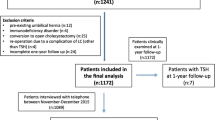Abstract
The incidence of port site hernia (PSH) after a range of laparoscopic procedures has been variously reported as between 0.14% and 22%. In addition to pain, PSH may be associated with severe complications, including bowel obstruction, strangulation, and perforation. The case is reported of Richter’s hernia in a 45-year-old male at a 5 mm port site 6 years after laparoscopic cholecystectomy (LC).He presented with a lump in the right lumbar region associated with sudden onset pain and non-passage of stool for two days. With a diagnosis of PSH, he underwent exploratory laparotomy with a right lumbar skin incision, which revealed herniation of the omentum and part of the antimesenteric wall of a small bowel loop through the port site defect of about 1 x 1 cm.
The gangrenous omentum was excised and the rest of the omentum and viable bowel loops were reposited.
PubMed database search 1991 to 2016 showed an incidence of PSH ranging from 0.38% to 5.4% with an overall incidence of 1.7% in a review from 1995 to 2008. The umbilicus was the most common port to be associated with incisional hernia. It is rarely associated with strangulation or bowel obstruction. Not closing the fascial defect is thought to be implicated, although closing the fascia is not preventive.
PSH at secondary port sites is very rare. Richter’s hernia with strangulation at a 5 mm port-site is the rarest presentation.
Similar content being viewed by others
References
Reynolds W Jr. The first laparoscop ic cholecystectomy. JSLS 2001;5:89–94.
Tonouchi H, Ohmori Y, Kobayashi M, et al. Trocar site hernia. Arch Surg 2004;139:1248–56.
Fear RE. Laparoscopy: A valuable aid in gynaecological diagnosis. Obstet Gynaecol 1968;31:297–309.
Hussain A, Mahmood H, Singhal T, et al. Long-term study of port-site incisional hernia after laparoscopic procedures. JSLS 2009;13:346–9.
Boldó E, Perez de Lucia G, Aracil JP, et al. Trocar site hernia after laparoscopic ventral hernia repair. Surg Endosc 2007;21:798–800.
McMurrick PJ, Polglase AL. Early incisional hernia after use of the 12mm port for laparoscopic surgery. Aust NZ J Surg 1993;63:574–5.
Bowrey DJ, Blom D, Crookes PF, et al. Risk factors and the prevalence of trocar site herniation after laparoscopic fundoplication. Surg Endosc 2001;15:663–6.
Johnson WH, Fecher AM, Mc Mahon RL, et al. VersaStepTM trocar hernia rate in unclosed fascial defects in bariatric patients. Surg Endosc 2006;20:1584–6.
Coda A, Bossotti M, Ferri F, et al. Incisional hernia and fascial defect following laparoscopic surgery. Surg Laparosc Endosc Percutan Tech 2000;10:34–8.
Nassar AH, Ashkar KA, Rashed AA, et al. Laparoscopic cholecystectomy and the umbilicus. Br J Surg 1997;84:630–3.
Plaus WJ. Laparoscopic trocar site hernias. J Laparoendosc Surg 1993;3:567–70.
Duron JJ, Hay JM, Msika S, et al. Prevalence and mechanism of small intestinal obstruction following laparoscopic abdominal surgery: A retrospective multicenter study. French Association for Surgical ResearchArch Surg 2000;135:208–12.
Lee JH, Kim W. Strangulated small bowel hernia through the port site: A case report. World J Gastroenterol 2008;14:6881–3.
Azurin DJ, Go LS, Arroyo LR, et al. Trocar site herniation following laparoscopic cholecystectomy and the significance of an incidental preexisting umbilical hernia. Am Surg 1995;61:718–20.
Mayol J, Garcia-Aguilar J, Ortiz-Oshiro E, et al. Risks of the minimal access approach for laparoscopic surgery: multivariate analysis of morbidity related to umbilical trocar insertion. World J Surg 1997;21:529–33.
Voyles CR, Petro AB, Meena AL, et al. A practical approach to laparoscopic cholecystectomy. Am J Surg 1991;161:365–70.
Larson GM, Vitale GC, Casey J, et al. Multipractice analysis of laparoscopic cholecystectomy in 1,983 patients. Am J Surg 1992;163:221–6.
Baird DR, Wilson JP, Mason EM, et al. An early review of 800 laparoscopic cholecystectomies at a university-affiliated community teaching hospital. Am Surg 1992;58:206–10.
Balakrishnan S, Samdani T, Singhal T, et al. Patient experience with gallstone disease in a National Health Service district hospital. JSLS 2008;12:389–94.
Sanz-Lopez R, Martinez-Ramos C, Nunez-Pena JR, et al. Incisional hernias after laparoscopic vs. open cholecystectomy. Surg Endosc 1999;13:922–4.
Munro MG. Laparoscopic access: Complications, technologies and techniques. Curr Opin Obstet Gynecol 2002;14:365–74.
Ahmad SA, Schuricht AL, Azurin DJ, et al. Complications of laparoscopic cholecystectomy: The experience of a universityaffiliated teaching hospital. J Laparoendosc Adv Surg Tech A 1997;7:29–35.
Bergemann J, Hibbert M, Harkins G, et al. Omental herniation through a 3-mm Umbilical trocar site: Unmasking a hidden umbilical hernia. J Laparoendosc Adv Surg Tech 2001;11:71–3.
Shafer DM, Khajanchee Y, Wong J, et al. Comparison of five different abdominal access trocar systems: Analysis of insertion force, removal force, and defect size. Surg Innov 2006;13:183–9.
Nakajima K, Wasa M, Kawahara H, et al. Revision laparoscopy for incarcerated hernia at a 5-mm trocar site following pediatric laparoscopic surgery. Surg Laparosc Endosc Percutan Tech 1999; 9:294.
Waldhaussen JH. Incisional hernia in a 5-mm trocar site following paediatric laparoscopy. J Laparoendosc Surg 1996;6:S89–90.
Moreaux G, Estrade-Huchon S, Bader G, et al. Five-millimeter trocar site small bowel eviscerations after gynaecologic laparoscopic surgery. J Minim Invasive Gynecol 2009;16:643–5.
Nezhat C, Nezhat F, Seidman DS, et al. Incisional hernias after laparoscopy. J Laparoendosc Adv Surg Tech 1997;7:111–5.
Reissman P, Shilloni E, Gofrit O, et al. Incarcerated hernia in a lateral trocar site–an unusual early postoperative complication of laparoscopic surgery. Case Report. Eur J Surg 1994;160:191–2.
Mahmoud HY, Ustuner EH, Sozener U, et al. Cannula site insertion technique prevents incisional hernia in laparoscopic fundoplication. Surg Laparosc Endosc Percutan Tech. 2007;7:267–70.
Maio A, Ruchman RB. CT diagnosis of postlaparoscopic hernia. J Comput Assist Tomogr 1991;15:1054–5.
Ramachandran CS. Umbilical hernial defects encountered before and after abdominal laparoscopic procedures. Int Surg 1998;83:171–3.
Yuen PM. Early incisional hernia following laparoscopic surgery. Aust N Z J Obstet Gynaecol. 1995;35:211–2.
David Mark Bunting. Port-Site Hernia Following Laparoscopic Cholecystectomy. JSLS 2010;14:490–7.
Uslu HY, Erkek AB, Cakmak A, et al. Trocar site hernia after laparoscopic cholecystectomy. J Laparoendosc Adv Surg Tech A 2007;17:600–3.
Author information
Authors and Affiliations
Corresponding author
Rights and permissions
About this article
Cite this article
Kumar, N. Port site Richter’s hernia. Case report and review. Hellenic J Surg 89, 166–171 (2017). https://doi.org/10.1007/s13126-017-0406-2
Received:
Accepted:
Published:
Issue Date:
DOI: https://doi.org/10.1007/s13126-017-0406-2



